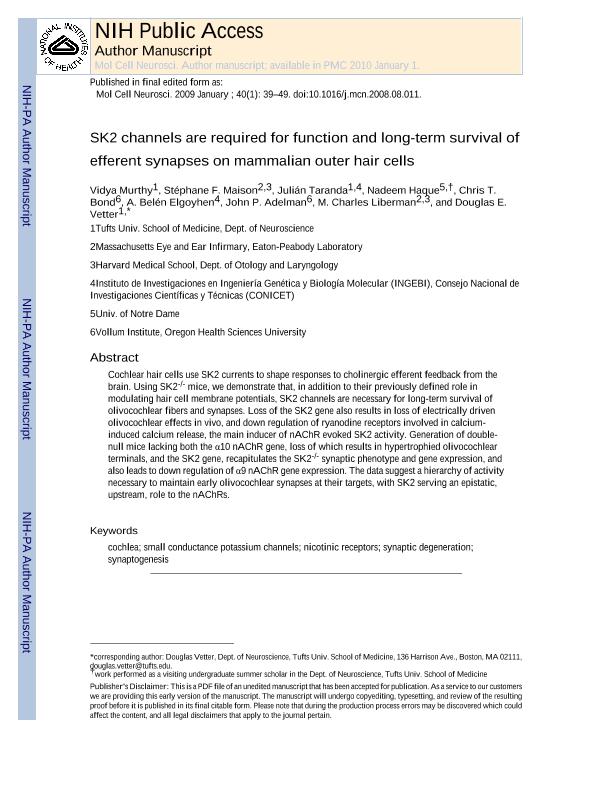Mostrar el registro sencillo del ítem
dc.contributor.author
Murthy, Vidya
dc.contributor.author
Maison, Stéphane F.
dc.contributor.author
Taranda, Julian

dc.contributor.author
Haque, Nadeem
dc.contributor.author
Bond, Chris T.
dc.contributor.author
Elgoyhen, Ana Belen

dc.contributor.author
Adelman, John P.
dc.contributor.author
Liberman, M. Charles
dc.contributor.author
Vetter, Douglas E.
dc.date.available
2019-07-16T14:23:49Z
dc.date.issued
2009-01
dc.identifier.citation
Murthy, Vidya; Maison, Stéphane F.; Taranda, Julian; Haque, Nadeem; Bond, Chris T.; et al.; SK2 channels are required for function and long-term survival of efferent synapses on mammalian outer hair cells; Academic Press Inc Elsevier Science; Molecular and Cellular Neuroscience; 40; 1; 1-2009; 39-49
dc.identifier.issn
1044-7431
dc.identifier.uri
http://hdl.handle.net/11336/79620
dc.description.abstract
Cochlear hair cells use SK2 currents to shape responses to cholinergic efferent feedback from the brain. Using SK2-/- mice, we demonstrate that, in addition to their previously defined role in modulating hair cell membrane potentials, SK2 channels are necessary for long-term survival of olivocochlear fibers and synapses. Loss of the SK2 gene also results in loss of electrically driven olivocochlear effects in vivo, and down regulation of ryanodine receptors involved in calcium-induced calcium release, the main inducer of nAChR evoked SK2 activity. Generation of double-null mice lacking both the α10 nAChR gene, loss of which results in hypertrophied olivocochlear terminals, and the SK2 gene, recapitulates the SK2-/- synaptic phenotype and gene expression, and also leads to down regulation of α9 nAChR gene expression. The data suggest a hierarchy of activity necessary to maintain early olivocochlear synapses at their targets, with SK2 serving an epistatic, upstream, role to the nAChRs.
dc.format
application/pdf
dc.language.iso
eng
dc.publisher
Academic Press Inc Elsevier Science

dc.rights
info:eu-repo/semantics/openAccess
dc.rights.uri
https://creativecommons.org/licenses/by-nc-sa/2.5/ar/
dc.subject
Cochlea
dc.subject
Nicotinic Receptors
dc.subject
Small Conductance Potassium Channels
dc.subject
Synaptic Degeneration
dc.subject
Synaptogenesis
dc.subject.classification
Bioquímica y Biología Molecular

dc.subject.classification
Ciencias Biológicas

dc.subject.classification
CIENCIAS NATURALES Y EXACTAS

dc.title
SK2 channels are required for function and long-term survival of efferent synapses on mammalian outer hair cells
dc.type
info:eu-repo/semantics/article
dc.type
info:ar-repo/semantics/artículo
dc.type
info:eu-repo/semantics/publishedVersion
dc.date.updated
2019-07-11T19:22:01Z
dc.journal.volume
40
dc.journal.number
1
dc.journal.pagination
39-49
dc.journal.pais
Países Bajos

dc.journal.ciudad
Amsterdam
dc.description.fil
Fil: Murthy, Vidya. Tufts University; Estados Unidos
dc.description.fil
Fil: Maison, Stéphane F.. Massachusetts Eye and Ear Infirmary; Estados Unidos. Harvard Medical School; Estados Unidos
dc.description.fil
Fil: Taranda, Julian. Consejo Nacional de Investigaciones Científicas y Técnicas. Instituto de Investigaciones en Ingeniería Genética y Biología Molecular "Dr. Héctor N. Torres"; Argentina. Tufts University; Estados Unidos
dc.description.fil
Fil: Haque, Nadeem. University of Notre Dame; Estados Unidos
dc.description.fil
Fil: Bond, Chris T.. Oregon Health Sciences University; Estados Unidos
dc.description.fil
Fil: Elgoyhen, Ana Belen. Consejo Nacional de Investigaciones Científicas y Técnicas. Instituto de Investigaciones en Ingeniería Genética y Biología Molecular "Dr. Héctor N. Torres"; Argentina
dc.description.fil
Fil: Adelman, John P.. Oregon Health Sciences University; Estados Unidos
dc.description.fil
Fil: Liberman, M. Charles. Massachusetts Eye and Ear Infirmary; Estados Unidos. Harvard Medical School; Estados Unidos
dc.description.fil
Fil: Vetter, Douglas E.. Tufts University; Estados Unidos
dc.journal.title
Molecular and Cellular Neuroscience

dc.relation.alternativeid
info:eu-repo/semantics/altIdentifier/url/https://www.ncbi.nlm.nih.gov/pmc/articles/pmid/18848895/
dc.relation.alternativeid
info:eu-repo/semantics/altIdentifier/doi/http://dx.doi.org/10.1016/j.mcn.2008.08.011
dc.relation.alternativeid
info:eu-repo/semantics/altIdentifier/url/https://www.sciencedirect.com/science/article/pii/S1044743108002431
Archivos asociados
